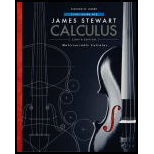
To choose: The appropriate option for the acceleration of the particle whose position at the time t is
Answer to Problem 1PT
The acceleration of the particle is
Explanation of Solution
Given that, the position of the given particle at the time t is
Obtain the acceleration for the particle as follows.
Differentiate the above function with respect to t.
Again, differentiate the function
So, the acceleration for the particle at the time t is
Hence, the acceleration of the particle is
Want to see more full solutions like this?
Chapter 13 Solutions
Study Guide for Stewart's Multivariable Calculus, 8th
 Linear Algebra: A Modern IntroductionAlgebraISBN:9781285463247Author:David PoolePublisher:Cengage Learning
Linear Algebra: A Modern IntroductionAlgebraISBN:9781285463247Author:David PoolePublisher:Cengage Learning
